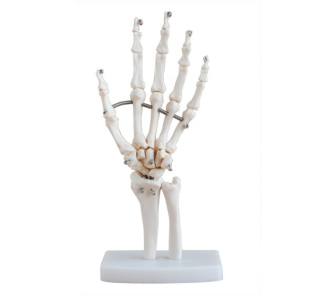Homepageпјҡ NEWS >> Does the hand joint model help to understand how the joint moves?
The hand joint model in medical education and clinical practice is indeed a significant help in understanding the joint movement mode. Here's a breakdown of this point:

Firstly, the hand joint model can display the anatomical structure and characteristics of the hand joint intuitively through its three-dimensional structure and accurate anatomical marks. This intuitiveness allows learners to clearly see the components of the joint, such as the articular surface, joint capsule, joint cavity, articular cartilage, and associated ligaments, muscles, and tendons. These components play different roles in the movement of the joint, and through the model, learners can intuitively understand the interactions and relationships between them.
Secondly, the hand joint model can simulate the motion mode and range of the joint. The joints on the model are usually movable and can simulate the movement of the joints in real life. The learner can manipulate the model and observe the movement of the joint in different directions, such as flexion and extension, expansion and rotation. This kind of simulation not only helps learners to understand the mechanism of joint movement, but also allows them to intuitively feel the smoothness and limiting factors of joint movement.
In addition, the application of hand joint model in teaching has the following advantages:
Deepen understanding: Through model demonstration and simulation operation, learners can have a deeper understanding of the structure and movement of joints, so as to establish a clearer and more accurate knowledge system.
Improve interest: The intuitiveness and interest of the model can stimulate learners' interest and enthusiasm in learning, so that they can participate in learning more actively.
Easy to remember: Through observation and operation of the model, learners can form a more profound impression and memory, so as to better grasp the relevant knowledge and skills.
In medical education and clinical practice, the application of hand joint models is not limited to understanding how joints move. It can also be used to demonstrate the pathological changes of joint injuries and diseases, helping learners to understand the pathogenesis and treatment of diseases. In addition, the model can also be used as an auxiliary tool for clinical practice and rehabilitation training to help medical students and rehabilitators improve practical skills and clinical operation ability.
To sum up, the hand joint model is of significant help in medical education and clinical practice to understand the joint movement mode. It allows learners to have a deep understanding of the structure and movement mechanism of joints through intuitive display and simulated operation, improve learning interest and enthusiasm, and lay a solid foundation for future clinical practice.